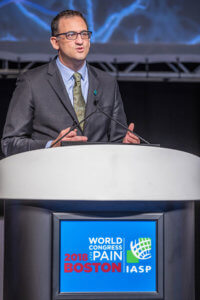In 2015, Matthew D’Uva became executive director of the International Association for the Study of Pain (IASP), where he now serves as CEO. As the world’s leading professional organization devoted to pain research and treatment, IASP brings together scientists, clinicians, health-care providers, and policymakers to stimulate and support the study of pain. As the association grows globally, D’Uva shares some of the challenges and opportunities of having a global membership with 100 chapters and members from more than 120 countries.

IASP executive director Matthew D’Uva speaks at the 2018 World Congress on Pain in Boston, Mass. (Courtesy IASP)
You have been quoted saying IASP was born as a global organization. What does that mean?
IASP is a global organization with members in more than 100 countries. Currently, one-third of our members are in Asia Pacific, Europe, and North America with the remaining members in Latin America and Africa. This geographic diversity existed nearly from our founding. Our headquarters in the United States is more directly related to our founder, Dr. John Bonica, who was an American. There are benefits of being located in Washington, D.C. There is a strong association community, and we can recruit from organizations that have a global mindset. We also work really hard on the training and development of our staff to ensure that they have the culture competency to support members around the world.
IASP has 100 chapters all over the world. How did the association grow to such a large number?
The association has always had an international membership. Most of chapter growth has been organic over time as members find the need to both connect with a global organization (IASP) as well as recognise the benefit of connecting with a chapter at a national level.
When I was in Dubai for the Dubai Association Conference at the end of 2017, I met with members who were interested in creating a chapter in the United Arab Emirates, we had great conversations, and they founded a chapter that IASP recognizes as our official chapter. One of the by-products of that particular trip was the path for IASP to develop a deeper relationship with members in the UAE, and this would not have taken place without being present in the region.
In terms of how we build connections with people, we have some core programs on which we base our organization, whether it be for young investigators in what we call “pain schools” or for clinicians in “pain camps.” Those are programs that we have in different parts of the world around which we form global partnerships. They represent opportunities for us to educate people about what a chapter can do for them, inspire them to build a chapter, and create a community wherever they are based.
Our strategy is to give members and the local organization the time needed to build something sustainable.
You use the term “glocal” referring to your presence in different parts of the world. What does this mean exactly?
We’ve been able to build programs that have been successful in different parts of the world, so when we’re looking to develop new markets, we have examples of programs that we can bring to markets we want to grow. In Southeast Asia, we developed the pain camps I mentioned earlier, which were embraced by local leaders. When we were looking to develop stronger connections in Latin America, we introduced those programs. For example, a successful fellowship program in Thailand was replicated in Colombia.
Local connections are paramount and we rely strongly on our members locally. We can demonstrate what has worked in Southeast Asia and see what is relevant for Latin America. It’s a pragmatic approach: Our members know what they need, know where the gaps are, and they need support from us to fill those gaps.
This means there’s no “one-size-fits-all” model?
Because we are a global organization, we attract people who think globally and who are engaged as global citizens. The people we are working with are usually people who have expertise due to their research background, as well as cultural appreciation of the context in which they are working. As far as global growth is concerned, it’s all about cultural competence and empathy.
We try to have real conversations where everybody is engaged to find solutions together. As a global organization, we’re going in and basically co-creating.
Is the ultimate goal to continue growing, to increase the number of chapters?
The ultimate aim is actually to grow our global partnerships to allow us to achieve our mission of relieving pain worldwide. We partner with other global organizations for our advocacy efforts and on programs we would not be able to manage by ourselves. Our goals for growth and membership are twofold: From a financial perspective, we’re looking to diversify our programs so that we may develop new opportunities to engage with members in different ways. This could be through the creation of new programs or the way we engage members and participants at our World Congress. In the end, it’s all about supporting a distribution hub for world-class science and evidence-based treatment to elevate the knowledge and education of members and the health-care community.
This article was contributed by Boardroom and is part of Boardroom’s alliance with the Global Associations Hub Partnership (GAHP). It was edited for use in Communique.

